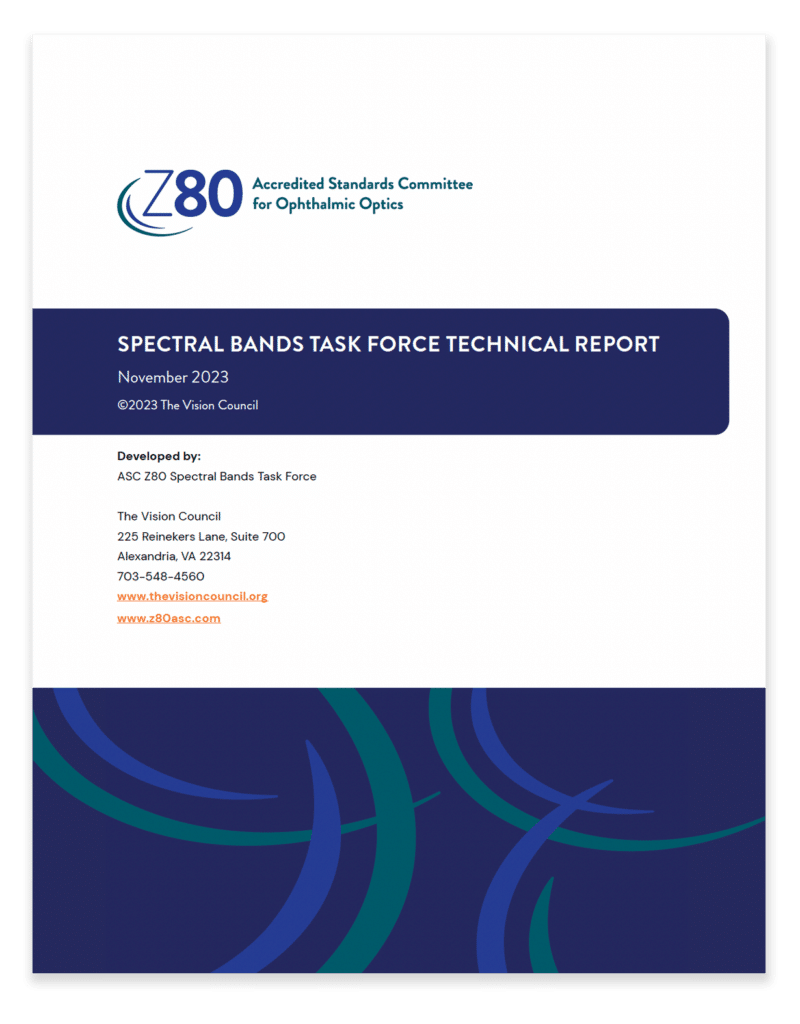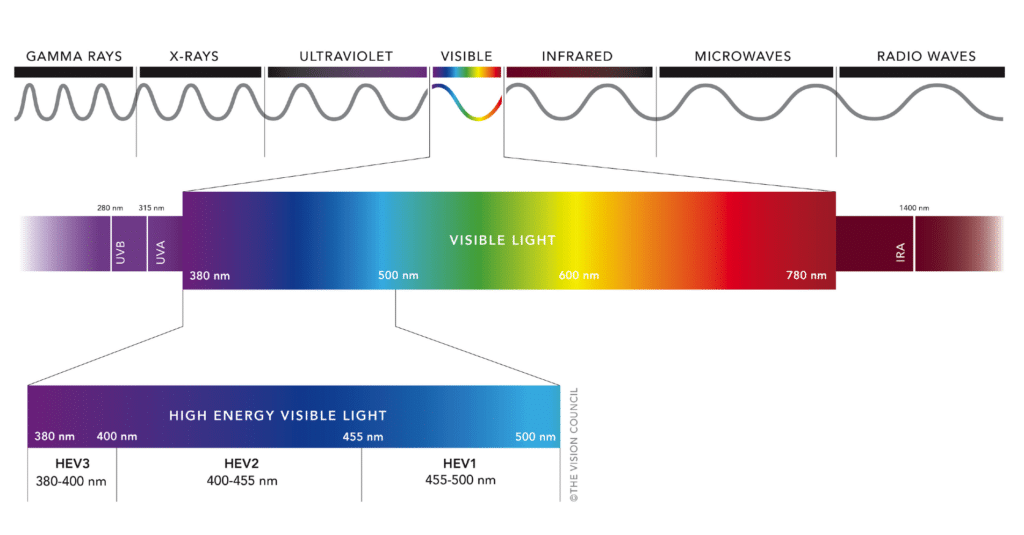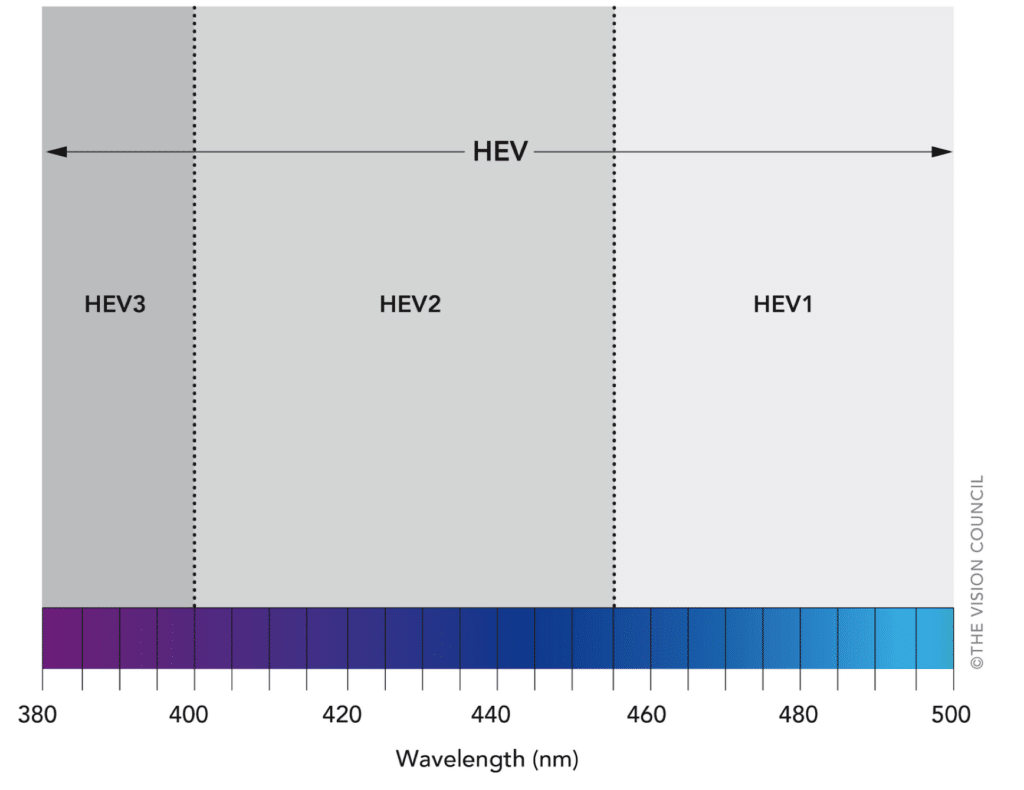In the last two decades, we’ve witnessed an extraordinary shift in the way we live. Entertainment, schooling, work, and even social interactions have shifted online. Now, adults use digital devices for an average of 11 hours per day.1 Many medical professionals believe prolonged screen time contributes to digital eye strain, sleep disruption, and even poor mental health.2 The growing list of health issues underscores the need for regulatory guidance, standards, and proactive measures to address our increasing reliance on screens.
ANSI ASC Z80 Spectral Bands Task Force
Blue light emissions are a primary concern related to excessive screen time, due to potential short-term and long-term health risks. The ANSI Accredited Standards Committee (ASC) Z80 Spectral Bands Task Force was formed in April 2021 to develop terminology/nomenclature for the spectrum of radiation between 380 – 500 nanometers (nm), commonly called “blue light”. The task force included The Vision Council and American Optometric Association, as well as Johnson and Johnson MedTech, Essilor Luxottica, Zeiss, Alcon, Eyesafe, and others.
The scope of the task force was to drive consensus on terms and explore the creation of sub-bands within the blue light range of the color spectrum. The task force agreed High Energy Visible (HEV) light would be the nomenclature describing the overarching band of radiation between 380 – 500 nm. Previously, HEV was used interchangeably with terms such as “blue light”, “violet light”, “blue-turquoise light”, “near UV-light”, etc. In addition, the task force identified three sub-bands within HEV: 380 – 400 nm (HEV 3), 400 – 455 nm (HEV 2), and 455 – 500nm (HEV 1).
Understanding the HEV Sub-Bands
Within the HEV range, the task force identified three sub-bands, HEV 3, HEV 2 and HEV 1.
-
HEV band scheme developed by the ANSI Z80 Spectral Bands Task Force to comprise the wavelengths of 380 – 500 nm with sub-bands of HEV3 (380 – 400 nm), HEV2 (400 – 455 nm) and HEV1 (455 – 500 nm). HEV 3 (380 – 400 nm): This sub-band represents the lower end of the blue light spectrum, near the border between ultraviolet and visible. This range has long been contested as visible light, so choosing it as a band unto itself enables further discussion to describe and define it.
- HEV 2 (400 – 455 nm): Covering the mid-range of blue light, this sub-band is of particular interest due to its potential impacts on retinal health and vision. The rationale for this band is tied back to an existing standard (ISO/TR 20772),3, which identified the range of 400 – 455 nm as a “harmful blue bandwidth” for age-related macular degeneration.4
- HEV 1 (455 – 500 nm): At the higher end of the spectrum, this sub-band extends into the turquoise range and is associated with circadian rhythm impact. Exposure, especially during the evening, can suppress the production of melatonin, affecting both the quantity and quality of sleep.5
The task force recommended when making claims regarding the blocking or filtering radiation in the range of 380 – 500 nm, a transmission spectrum for the full range of 380 – 500 nm should accompany those claims. There was concern that filtration within a specific band could be used to communicate a safety profile that would be incomplete.
Implications for the Consumer Electronics Industry
The decision to categorize the overarching band of radiation as High Energy Visible (HEV), with the creation of three sub-bands (HEV 3, HEV 2, and HEV 1), has several implications for the consumer electronics industry.
- Product Design and Development: OEMs and panel manufacturers producing PCs, computer monitors, TVs, smartphones and tablets need to consider the specific characteristics of HEV light in their design and development process. This may include implementing hardware technologies or software solutions to reduce HEV light.
- Display Technology: The categorization of HEV light and its sub-bands may influence the type of display technologies chosen by manufacturers. For instance, there may be an increased focus on developing displays that emit less blue light within the HEV 2 band, as this is considered to have a higher potential risk to our eyes.
- Regulatory Compliance: As awareness increases, regulatory bodies may impose guidelines or standards related to HEV emissions. The consumer electronics industry would need to ensure their products comply with such regulations, which could impact product design and require additional testing and certifications.
- Innovation and Competition: The categorization of HEV and associated sub-bands could drive innovation within the industry. Companies that develop effective solutions to minimize HEV will have a competitive advantage, as consumer preferences shift toward products that prioritize wellbeing.
In the Spectral Bands Task Force Technical Report, released November 2023, the Vision Council remarked “The team largely benefited from discussion about the work in [the display technology] industry, specifically exposure to the Radiance Protection Factor (RPF). Developed by Eyesafe, RPF helps convey the blue light (i.e. HEV) protection provided by a display. It is based on the blue light hazard weighting function and has been adopted by TÜV Rheinland and leading electronics companies.”
Michael Vitale, Vice President of Membership, Government Relations & Technical Affairs at The Vision Council, stated, “The publication of the Spectral Bands Task Force Technical Report marks a significant milestone for standards in the eyecare industry. This uniformity of terminology is crucial for manufacturers, as it ensures consistency and clarity in the production and marketing of eyewear. We, as The Vision Council, are proud to have helped facilitate this advancement and remain committed to upholding the best standards for our industry.”
In summary, the decision to categorize HEV and its sub-bands has the potential to influence consumer electronics, from product design and regulatory compliance to marketing strategies and competition. Manufacturers will need to adapt to changing consumer preferences and health concerns.
Evolution of Eyesafe® Display Requirements
The Eyesafe Display Requirements 2.0, released in May 2022, measures Blue Light Toxicity Factor (BLTF). To achieve Eyesafe® Certification, a display must have a BLTF less than 0.085 (RPF 35). This metric, derived from the blue light-weighting function, centers on the range of 435-440 nm. This range identifies the potential risks posed by light emissions reaching the retina.6
With ongoing research on the retinal impact of blue light, one area of science is well documented: the correlation of HEV light and disrupted sleep. Too much blue light exposure from viewing screens at night may result in sleep deficiency, which can adversely impact performance, health, and safety.5
To align with ASC Z80 and address the broader impacts of HEV, Eyesafe is currently evaluating an evolution of Eyesafe Display Requirements. The next set of requirements may cover the wavelengths of sub-bands HEV 2 and HEV 1, addressing potential vision and circadian impacts of HEV light. More information will be released in 2024.
Download your free copy of the Spectral Bands Task Force Technical Report from the American National Standards Institute (ANSI) Accredited Standards Committee Z80.
1 Eyesafe estimate based on Nielsen Total Audience Reports, 2018-2023, US. Some amounts of simultaneous usage may occur across devices.
2 Consolidated research available at https://eyesafe.com/research
3 ISO/TR 20772:2018 Ophthalmic optics – Spectacle lenses – Short wavelength visible solar radiation and the eye
4 Arnault E. Phototoxic Action Spectrum on Retinal Pigment Epithelium Model of Age-related Macular Degeneration Exposed to Sunlight Normalized Conditions. PlosOne. 8, 2013.
5 Chang AM, et al. Evening use of light-emitting eReaders negatively affects sleep, circadian timing, and next-morning alertness. Proceedings of the National Academy of Sciences of the United States (PNAS). January 2015. 112(4): 1232-1237.
6 The blue light hazard function B(λ) represents the relative spectral sensitivity of the human eye to the blue light hazard ranging from 380 nm to over 500 nm (with a peak at 435-440 nm).

